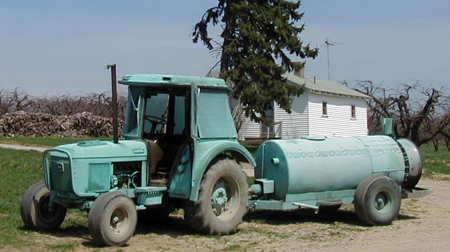Southwest Michigan fruit update
Fruit growth will accelerate with this warm week ahead.
The cool weather this last week has held plant growth back and no fruit farmers are complaining. Warmer weather this week should start growth again. Growers should see a growth spurt late this week with highs climbing into the 60s by the weekend and lows climbing through the 40s into the 50s. There is still time to get dormant sprays on many fruit plantings this week and lows will be above freezing for the foreseeable future. There is a good chance of rain most of the week.
As you look back over the years it seems that the early springs are dividing into groups cool and warm and 2011 is in the cool group. A warm weekend like the one that is coming can easily move us into the middle group. You can check for a local weather station at: www.enviroweather.com.The upcoming rainy days would be a good time to calibrate your weed spray to apply soil active herbicides to control weeds.

Copper is a common dormant spray to provide early season disease control in apples, cherries, peaches and grapes.
Tree fruit
Most tree fruit buds are still at first swell. At this stage, overnight lows of 15°F can cause some damage but lows of 5°F or lower would be needed to cause severe damage to fruit flower buds. As fruit buds develop they become more susceptible to freezing injury.
Apricots are at swollen bud and the tips of the most advanced buds are opening.
Peaches are at first swell and past the dormant copper window to control peach leaf curl. There is still time to apply materials such as ziram or chlorothalonil to reduce leaf curl symptoms.
Sweet cherry buds are obviously swollen and well advanced. There is still time to apply copper to reduce bacterial canker later in the season. Tart cherries are less advanced but swelling is apparent on many buds.
In plums, Japanese plums are well advanced at white side while European plums are at the beginning of bud swell. Black knot symptoms are easy to see and the infected black swellings should be cut out to slow the spread of the disease.
Apples are at silver tip. Zestar in Berrien County is starting to show green tissue. The return of warm weather and plant growth will expose green tissue that will be susceptible to apple scab infection in the upcoming rains. Growers can use the scab infection tool on the enviroweather website to track infection periods. There are more and more fruit related prediction tools on enviroweather.
Pears are beginning to swell and pear psylla will be out when warm weather returns.
Small Fruit
There is a workshop on identifying SWD (Spotted Winged Drosophila) at the Trevor Nichols Research Center on April 11. Preregistration is required and English and Spanish sessions are available.
Grapes are dormant and show no signs of growth.
Blueberries are generally dormant but flower buds of the early blooming varieties are moving. Applications of lime sulfur or Sulforix now will help reduce phomopsis and anthracnose shoot blight later in the spring during rainy weather. Eric Hanson has written an update on blueberry herbicides available this year.
Strawberries have new leaves emerging from the crown. Mulch should have been removed by now. Now is a good to apply preemergent herbicides for early season weed control.
In brambles, black and red raspberry buds have begun to move and green tissue is showing. Blackberries are still dormant. Summer bearing plantings should be pruned back as soon as possible, if that has not already been done. Delayed dormant applications of lime sulfur will help reduce anthracnose in plantings were this disease is a problem.



 Print
Print Email
Email




